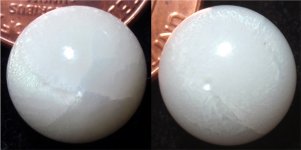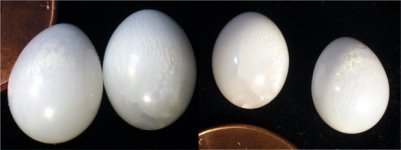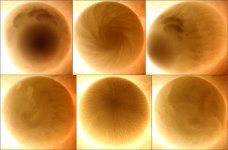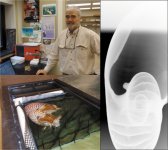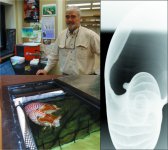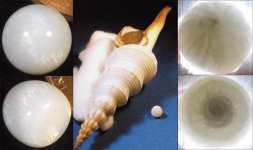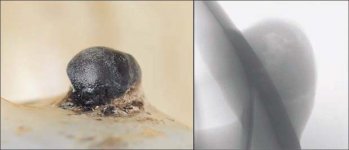You are using an out of date browser. It may not display this or other websites correctly.
You should upgrade or use an alternative browser.
You should upgrade or use an alternative browser.
Nautilus pearl
- Thread starter effisk
- Start date
SteveM
Well-known member
- Joined
- Jan 29, 2007
- Messages
- 2,113
Or swirling wine?Oh, that's unusual and elegant! Perhaps a smaller one without the handle for sipping wine??
SteveM
Well-known member
- Joined
- Jan 29, 2007
- Messages
- 2,113
Asked for a closer view of the 'quarter-spheres', left below is a new shot of the freshly-harvested pearl. This pattern seems to be related, as with the swirl/spiral feature, to symmetrical bio-mineralization during the periodic and frenetic secretion of new chamber septae/walls. Pearl on the right is a close pairing, same weight, slightly less wide but taller.The pearl is very attractive, 6.45 carats and 11mm wide by 8mm tall. It conforms to all Nautilus ID characteristics, albeit its swirl or spiral structure is not acute, rather more like four interrelated quarter-spheres (think any plate tectonics are underway in there?!). The chatoyance is beautiful with blue iridescence and more than a hint of swirl. The skin, perhaps partly owing to the pearl's freshness, is silky smooth.
Attachments
SteveM
Well-known member
- Joined
- Jan 29, 2007
- Messages
- 2,113
Introduction to the website of the Indonesian Coral Reef Foundation:
Here are two more, an amazingly matched teardrop pair collected by an individual of specified name, age and island origin approximately two decades ago. Both pearls have been treasured in the family as Nautilus.
The two pearls' positions are switched in the two photos. Each are 5.45 carats, one 8.1mm x 10.9mm and the other 8.1mm x 11mm.
Nautilus pearl candidates from all corners of this vast maritime country remain without a nacreous example.Indonesia is the largest archipelagic state in the world with 17,508 islands, from which 6,000 islands are inhabited. Comprising 14 per cent of the Earth's about 81,000 km, Indonesia has the longest coastline in the world. It also has a sea area of about 5.8 million square km, representing approximately 70 % of its total territory.
Here are two more, an amazingly matched teardrop pair collected by an individual of specified name, age and island origin approximately two decades ago. Both pearls have been treasured in the family as Nautilus.
The two pearls' positions are switched in the two photos. Each are 5.45 carats, one 8.1mm x 10.9mm and the other 8.1mm x 11mm.
Attachments
SteveM
Well-known member
- Joined
- Jan 29, 2007
- Messages
- 2,113
The top row of candling photos below is of pearl 1 and 4 (left and right) in the previous post. The bottom row is of pearl 2 and 3 (the middle two).
The pearl in the top row is self-explanatory. Quite spectacular and well-constructed, a textbook (??) Nautilus pearl of remarkable symmetry and delicacy.
The pearl in the bottom row is not ('naut') Nautilus, rather a strangely secreted conch or tridacna pearl. Its orderly, flamed top (center) seems at total odds with its chaotic, largely organic, bottom.
Nonetheless, an attractive pair.
The pearl in the top row is self-explanatory. Quite spectacular and well-constructed, a textbook (??) Nautilus pearl of remarkable symmetry and delicacy.
The pearl in the bottom row is not ('naut') Nautilus, rather a strangely secreted conch or tridacna pearl. Its orderly, flamed top (center) seems at total odds with its chaotic, largely organic, bottom.
Nonetheless, an attractive pair.
Attachments
Last edited:
GemGeek
Pearlista
But, can you be sure of the nots, really? I think you can be sure of the polar-swirl pearls, but suppose there are other nautilus pearls that do not display the swirl? Hmmm... 
SteveM
Well-known member
- Joined
- Jan 29, 2007
- Messages
- 2,113
There's nothing for sure where Nautilus is concerned!But, can you be sure of the nots, really?
Just got back from our long-awaited meeting with Professor Ward at UW, a super guy as can be surmised from the photo. He was duly impressed with the SIZE of our shells. We got to feed his Nautiluses (three younger ones from the Philippines in a tank in his lab) and radiographed our shells. Probably the most interesting result from the X-Rays is that the dark bluish growth on our largest shell turns out to be calcareous and not organic, showing up crisply in the image. A closer look also showed internal cavities that indicated its formation around an irritant, as it should be.
In conversation, Dr. Ward confirmed that he would suppose a Nautilus pearl to be non-nacreous given the porcelanous lining of the shell. And as we have discussed here, where the porcelanous lining of the shell is thinnest, at the aperture, the aggressive activity of the mollusk would prevent pearl or pearl blister formation.
Dr. Ward has kindly offered to culture blisters in his live animals, but this does not appear likely to give insightful results. And culturing a whole pearl is highly doubtful, as Dr. Ward confirmed the 'nether regions' where a pearl might form and be retained are inaccessible, since the animal is hard against the septum and attached by its retractor muscles to the shell except during the brief period it scoots forward to begin building another chamber.
Attachments
Last edited:
SteveM
Well-known member
- Joined
- Jan 29, 2007
- Messages
- 2,113
Today they dined on frozen shrimp with shells. That should settle all arguments about fresh vs. frozen!Gosh! Just what did you feed the Nautilus? I'm so glad you were able to meet! The radiograph of the Nautilus is just gorgeous----------is that different from an x-ray?
Radiograph is X-Ray (-diograph) but I believe it's most frequently employed at the level of micro-radiography.
GemGeek
Pearlista
Steve, I can't see the picture! Can you email it to me? I'm just seeing a little red x.
It sounds like you had a great time. Tomorrow a.m. I am visiting the curator of paleontology at our natural history museum here. I can't wait to tell him about your adventure as he is sure to know Peter Ward.
It sounds like you had a great time. Tomorrow a.m. I am visiting the curator of paleontology at our natural history museum here. I can't wait to tell him about your adventure as he is sure to know Peter Ward.
SteveM
Well-known member
- Joined
- Jan 29, 2007
- Messages
- 2,113
No problem!Steve, I can't see the picture! Can you email it to me? I'm just seeing a little red x.
It sounds like you had a great time. Tomorrow a.m. I am visiting the curator of paleontology at our natural history museum here. I can't wait to tell him about your adventure as he is sure to know Peter Ward.
I forgot to mention one other thing pertinent to the pearl world. Professor Ward goes way back with Sue Hendrickson of conch pearl fame. As those who have read Hubert Bari's 'The Pink Pearl' know well, in Hendrickson's prior life as a paleontologist she unearthed the fossil dinosaur ever since known as 'Sue.' Ward recalled her bringing a big bag of beautiful conch pearls to their last meeting.
newberry
Well-known member
Steve would you mind reposting the picture because I only have a red X too.
GemGeek
Pearlista
SteveM
Well-known member
- Joined
- Jan 29, 2007
- Messages
- 2,113
In accordance with the investigative journalism vein of this thread, there are a couple of new developments to report.
Hubert Bari?s Pearls
Ken Scarratt of GIA Bangkok again stopped in Seattle to check our most recent pearls and to collect the Nautilus shell with blisters for microradiograph analysis at GIA New York.
Ken brought along his preview copy of Hubert Bari?s much-anticipated new book, Pearls, which documents the greatest natural pearl exhibition assembled in recent times (perhaps the greatest such exhibition ever, considering its unprecedented global reach). Release date for the book is not until mid-September. The exhibition and book, finished prior to most of the reporting on this thread, include two ?Nautilus pearls? that are absolutely gorgeous in the book?s photography. They show the ringed chatoyance typical of fine Tridacna pearls that continues to be a major source of doubt among the skeptics. Ken said that the pearls had come direct from divers and that their provenance was reliable, and that one of the pictured pearls had received certified Nautilus ID. So officially there are now two GIA-certified Nautilus pearls.
Upon asking about the similarity to fine Tridacna pearls, Ken simply stated that there are other precedents for Tridacna-like white pearls from mollusks other than Tridacna family, and that such appearance should not be an eliminating factor. Upon my reminder of the shell with nacreous blister posted earlier in this thread, he observed that nacreous Nautilus pearls may also be possible.
(Side note: There is an error in Bari's text regarding the buoyancy of Nautilus, which is described as the means by which Nautilus accomplishes its daily vertical migration. Buoyancy is in actuality kept neutral for resting depth, changing slowly to compensate for growth, or loss of mass. Source: P. Ward.)
Molluscus Abominabilis
The pearl pictured is 6.8mm x 7.1mm in height, 2.6 carats. The Fusinus is a smallish species and would not account for the earlier pearls in this thread measuring 13mm and up, however.
And again, we have only the diver?s word that the pearl was from Fusinus.
Just as various species may be capable of producing non-nacreous white pearls with chatoyance patterns similar to fine Tridacna, we must also assume such to be the case with fine Fusinus.
Conclusion:
Hubert Bari?s Pearls
Ken Scarratt of GIA Bangkok again stopped in Seattle to check our most recent pearls and to collect the Nautilus shell with blisters for microradiograph analysis at GIA New York.
Ken brought along his preview copy of Hubert Bari?s much-anticipated new book, Pearls, which documents the greatest natural pearl exhibition assembled in recent times (perhaps the greatest such exhibition ever, considering its unprecedented global reach). Release date for the book is not until mid-September. The exhibition and book, finished prior to most of the reporting on this thread, include two ?Nautilus pearls? that are absolutely gorgeous in the book?s photography. They show the ringed chatoyance typical of fine Tridacna pearls that continues to be a major source of doubt among the skeptics. Ken said that the pearls had come direct from divers and that their provenance was reliable, and that one of the pictured pearls had received certified Nautilus ID. So officially there are now two GIA-certified Nautilus pearls.
Upon asking about the similarity to fine Tridacna pearls, Ken simply stated that there are other precedents for Tridacna-like white pearls from mollusks other than Tridacna family, and that such appearance should not be an eliminating factor. Upon my reminder of the shell with nacreous blister posted earlier in this thread, he observed that nacreous Nautilus pearls may also be possible.
(Side note: There is an error in Bari's text regarding the buoyancy of Nautilus, which is described as the means by which Nautilus accomplishes its daily vertical migration. Buoyancy is in actuality kept neutral for resting depth, changing slowly to compensate for growth, or loss of mass. Source: P. Ward.)
Molluscus Abominabilis
I?ve continued to search for alternative explanations to Nautilus for the vortex structure in non-nacreous pearls. A prominent and respected internet source for fine and rare shells and occasional pearls posted a photo of a non-nacreous pearl showing spiral chatoyance pattern. I was able to procure the pearl and a specimen of its purported shell, the gastropod Fusinus Colus.So I will herewith re-christen Caitlin's Null hypothesis as the Abominable Mollusk Hypothesis.
The pearl pictured is 6.8mm x 7.1mm in height, 2.6 carats. The Fusinus is a smallish species and would not account for the earlier pearls in this thread measuring 13mm and up, however.
And again, we have only the diver?s word that the pearl was from Fusinus.
Just as various species may be capable of producing non-nacreous white pearls with chatoyance patterns similar to fine Tridacna, we must also assume such to be the case with fine Fusinus.
Conclusion:
There's nothing for sure where Nautilus is concerned!
Attachments
Last edited:
GemGeek
Pearlista
I can't see the photos, just little red x's. Very interesting information. I can't wait to hear and see more. The adventure continues...
When we were in Guaymas, Douglas showed us the Bari book - simply outstanding!
When we were in Guaymas, Douglas showed us the Bari book - simply outstanding!
SteveM
Well-known member
- Joined
- Jan 29, 2007
- Messages
- 2,113
The Nautilus image in Pearls was published online over one year ago by The Pearl Professor.
Below are the two published pearls, along with a beautiful 26-carat Tridacna Maxima that I should probably reconsider?
There will be those who view Bari?s inclusion of Nautilus as an aberration in an otherwise highly credible work. Such inclusion will be characterized as premature until ID based on objective scientific analysis can be provided, or until such time as Nautilus can be easily differentiated from other pearl types with the unassisted eye.
It was not too many years ago that melo-melo was determined to be something other than a rare conch (thanks to Ken Scarratt!). Following positive ID there has been no subsequent confusion between the two.
Below are the two published pearls, along with a beautiful 26-carat Tridacna Maxima that I should probably reconsider?
There will be those who view Bari?s inclusion of Nautilus as an aberration in an otherwise highly credible work. Such inclusion will be characterized as premature until ID based on objective scientific analysis can be provided, or until such time as Nautilus can be easily differentiated from other pearl types with the unassisted eye.
It was not too many years ago that melo-melo was determined to be something other than a rare conch (thanks to Ken Scarratt!). Following positive ID there has been no subsequent confusion between the two.
Attachments
Last edited:
SteveM
Well-known member
- Joined
- Jan 29, 2007
- Messages
- 2,113
Our Nautilus shell with blister formation has been returned by GIA, along with excellent photographs and microradiographs.
GIA interpretation of the radiographs is that beneath the organic/conchiolin surface there is indeed an object made of the same material as the shell that is attached to the shell, and an unidentified irritant at the center.
So it is officially a Nautilus Blister Pearl.
I suppose it should be peeled to see what it looks like. But that would risk ending all the speculation?
GIA interpretation of the radiographs is that beneath the organic/conchiolin surface there is indeed an object made of the same material as the shell that is attached to the shell, and an unidentified irritant at the center.
So it is officially a Nautilus Blister Pearl.
I suppose it should be peeled to see what it looks like. But that would risk ending all the speculation?
Attachments
Last edited:
Caitlin
Well-known member
Interesting photos. I didn't realize it was covered with conchiolin. I wonder what the surface looks like?
lisa c
Perpetual Pearl Student
ditto, for only little red Xs. sad face.
Similar threads
- Replies
- 99
- Views
- 18K
- Replies
- 2
- Views
- 2K

